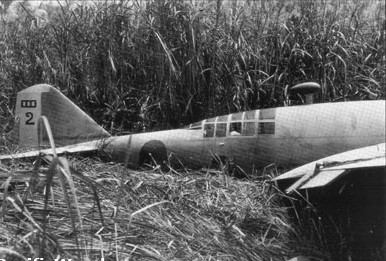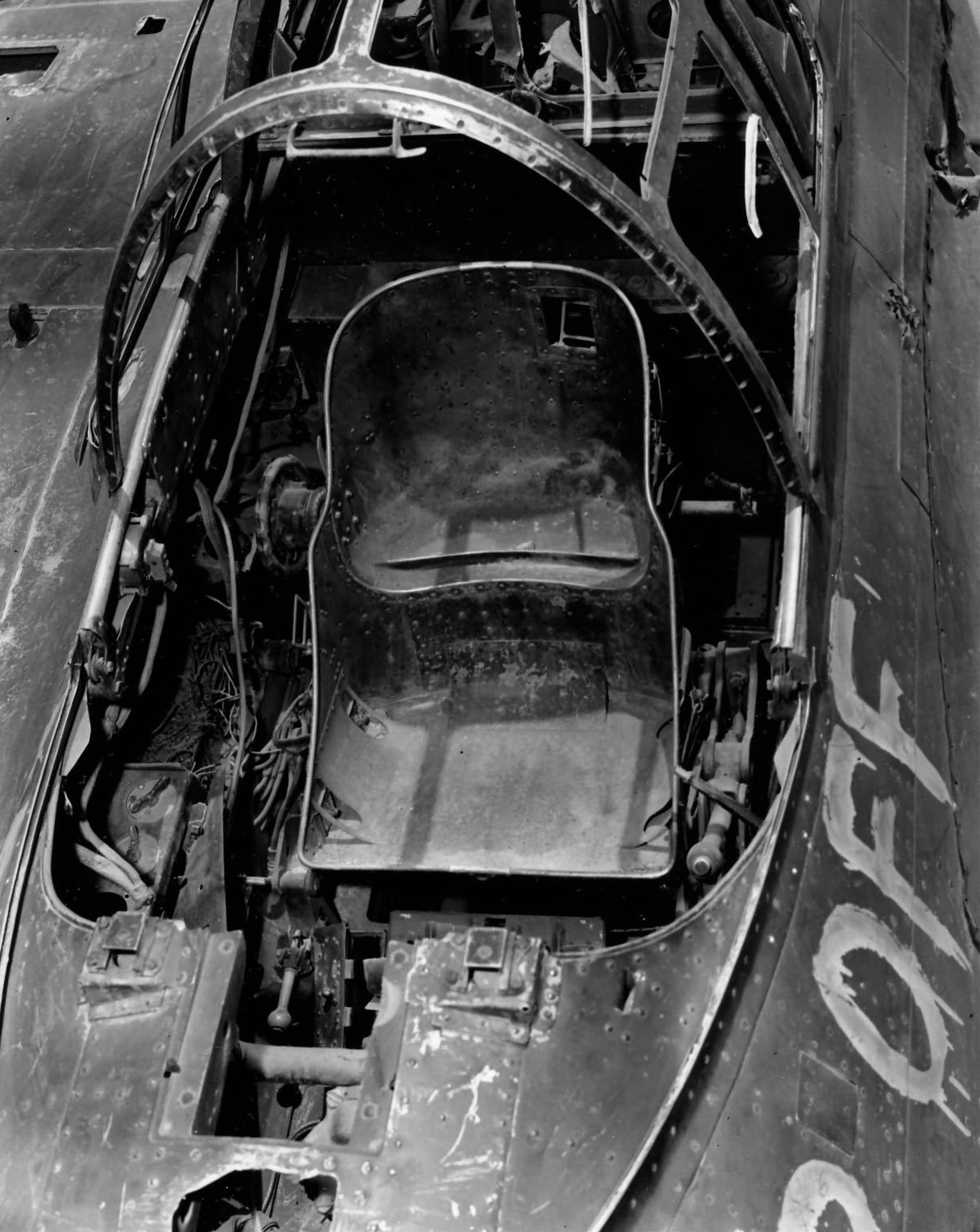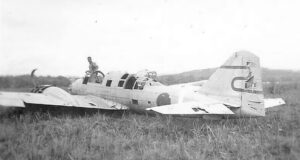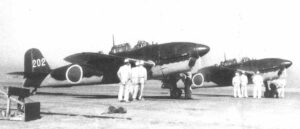The Type 100 Headquarters Reconnaissance Plane commonly referred to simply as headquarters reconnaissance airplane (Shin-Shitei) was given the codename Dinah by Allied forces in the Pacific. Arguably it was one of Japan’s most successful aircraft. As elucidated in South Pacific Air War Japan’s Southeast Area, which included eastern New Guinea, New Britain and the Solomon Islands, was a critical area of the Pacific Theater from mid-1942 to early 1944. Relatively little has been written about the exploits of the Dinah in this area. For example there is a book claiming, “This book analyzes in depth the air war between Japan and the Allies in the South Pacific during World War II.” In more than six hundred pages there is not one mention of the Dinah. This brief article, while an incomplete treatment of the subject contains details not previously published and gives some perspective on the role the aircraft played in important events.
The 76th Hikochutai – Operations
The Type 100 recce first appeared in the Southeast Area months before other Japanese Army Air Force aircraft as part of the 76th Dokuritsu Hikochutai, Independent Squadron (Fc). The unit started the Pacific War equipped with the Type 97-II HQ reconnaissance plane (Ki-15) in the Philippines campaign. It was still in the Philippines in September 1942 but flying the Type 100 model II (Ki 46-II) when it was ordered to transfer to Rabaul on New Britain Island, the key Japanese base in the Southeast Area, where battles on Guadalcanal were raging. Transported to the area by navy auxiliary aircraft carrier the unit arrived at Rabaul in early October with six aircraft. The unit was based at Rabaul-East airfield (Lakunai).
Ground combat on Guadalcanal was reaching a climax for the Japanese. The Ichiki Detachment attack in August 1942 had been decisively repulsed. The Kawaguchi offensive in September had also failed. In October the reinforced Japanese, after operations along the Matanikau River, prepared their largest offensive operation. Due to the jungle terrain they remained unsure of the enemy line and their own troops were sometimes uncertain of their positions. Shin-Shitei photo reconnaissance missions on 13 and 14 October revealed what appeared to be U.S. Marine fortifications and supply concentrations which if attacked could disrupt the American line. This information seemed to staff officers at Rabaul key to the coming operation’s success. They persuaded the navy to get the photos and their analysis to Guadalcanal. On 17 October documents and photographs were prepared for an air drop to 17th Army commanders on the island. A type 1 land attack bomber escorted by twelve Zero fighters delivered the load. It reached the hands of the officers concerned, who either did not understand or dismissed its significance. The Japanese ground offensive beginning on the 20th and lasting a week resulted in disappointing failure. Moreover what might have been a high point for the newly arrived reconnaissance squadron resulted in tragedy.
Tail Marking of 76 Fc and 10 FR
Late on October 24th the commander of the 17th Army was advised that troops had advanced to and captured the airfield (Henderson Field). Rabaul was duly notified. This erroneous report was corrected in a subsequent message. Apparently an accurate account of the situation failed to reach all commands at Rabaul before the following morning. Many aircraft were active over Guadalcanal that day but the first to arrive was a Shin-Shitei flown by 76th Squadron commander Capt. Hideo Kirita. Kirita was surveying conditions on the airfield or according to the impression of some observers preparing to land when he was sighted. The unfamiliar twin-engine aircraft flying low and slow was recognized as an enemy and became the target of anti-aircraft and small arms fire from dozens of weapons. The stricken aircraft crashed near the airfield. There is no crash inspection report for the aircraft. It was only much later that artifacts recovered from the crash site revealed it was a Japanese Army aircraft, the first downed in the Southeast Area (U.S. South Pacific Area). Capt. Hideo Shinohara succeeded to command of the squadron. The unit was challenged with providing reconnaissance not only of Guadalcanal and the Solomons but also New Guinea where a Japanese ground offensive had stalled, and a retreat was in progress. For example, Shinohara had flown a mission over Port Moresby on 19 October.
An interesting incident occurred on the morning of 24 November when 1Lt. Hiramatsu flew a photo mission to Buna area airfields. Later he flew 3,500 meters (11,500 ft.) over Cape Harvey southeast of Buna. Photos revealed three P-40s flying beneath his reconnaissance plane. No interception took place. Activities of the squadron went unreported in Allied intelligence reports during November and most of December probably because they were unnoticed. That changed in mid-December when reconnaissance planes were reported over the Trobriands and other islands off the New Guinea north coast several days in succession. These missions may have been flown at lower altitude than missions against targets where opposition was expected. On 28 December 1Lt. Verl Jett flying a P-39D of the 36th Fighter Squadron claimed a “Type 108” shot down over Goodenough Island in what may have been the chutai’s second loss in the region. Also during December 1Lt. Hiramatsu reconnoitered and photographed the area around Salamaua. 1Lt. Sayeki photographed the route from Lae to Wau. Missions were also flown along the route from Salmaua to Wau. The results were used in planning the Japanese advance against Wau in January 1943.
In January 1943 Shin-Shitei photo missions supported the Japanese operation to evacuate troops from Guadalcanal, KE-go. One such mission was flown by Sgt-Maj. Yamadani and his observer 1Lt. Tanaka on 18 January. Sightings of high attitude reconnaissance airplanes by the Allies picked up during January and February. However, not all of these were 76th Fc aircraft. As will be described below the Japanese navy was also operating the Shin-Shitei. Intrusions over Port Moresby, Milne Bay and other bases were noted. Missions were flown as far afield as Merauke on New Guinea’s south coast and even over Horn Island off the Australian mainland.
In late February and early March the Japanese mounted an effort to suppress Allied air power prior to the Battle of the Bismarck Sea. As pointed out in South Pacific Air War, p. 166, the failure of this effort was considered a key reason for the disaster which befell the Japanese convoy operation by certain Japanese leaders in their post-war interrogations. The Army-Navy agreement for the operation tasked the Army for five headquarters recon planes. The Navy’s reconnaissance commitment was limited to reconnaissance floatplanes. In his post-war opinion one navy staff officer specifically assigned blame to the inadequacy of aerial reconnaissance supporting the Japanese pre-convoy air campaign. This seems to be a disingenuous effort to shift blame to the Japanese army which conducted much of the reconnaissance rather than the navy which carried out (more correctly, failed to vigorously carry out) most attacks against assigned targets.
Later in March and in April and May navy land attack bombers and army “heavy bombers” bombers carried out several successful attacks on Allied airfield and shipping targets. This suggests they might have done so before the Bismarck Sea convoy operation. A desire to preserve the fighter force intact for convoy escort duty, weather concerns or simply lack of will to confront the enemy defenses may have been the reason for the earlier ineffective performance. For the Japanese army May brought unwarranted concern about Allied airfield developments in the New Guinea highlands as well as continuing focus on the area of ground combat operations around Wau and Salamaua. Examples include a photo mission over Bulldog by 1Lt. Takahashi on May 20; a mission to photograph airfields around Mt. Wilhelm on May 27; airfields at Kainantu on June 6; and, by 1Lt. Takahashi over Bena Bena on 8 June. All were flown by a recently arrived squadron.

Tail Marking #2485
JAAF Strategic Reconnaissance Reorganized
The 6th Flying Division (Hikoshidan) arrived at Rabaul in December 1942 and took command of the 76th and a fighter Flying Brigade (Hikodan) to which the 76th was subordinated during KE-go. As plans went forward to expand the JAAF presence in the Southeast Area the reconnaissance force grew. In April the authorized strength of the 76th was increased from nine to twelve aircraft. A three-squadron reconnaissance flying regiment in Burma (81st FR) gave up a squadron which arrived at Wewak in early May with eight Shin-shitei. On 6 May five were sent on to Rabaul (1Lt. Fujimoto commanding) while three stayed at Wewak and operated under the Shirogane flying brigade (1Lt. Takahashi). They conducted the operations mentioned in the previous paragraph. In June the two reconnaissance squadrons joined together to become the 1st and 2nd chutai of the 10th FR commanded by Lt. Col. Heiichi Shimomura. Aircraft carried a tail marking resembling a highly stylized reverse “S” or “2”.
The tempo of the air war increased to the extent that the call went out for additional air assets. The 74th Fc in the Southwest Area and the 81st Fc (not to be confused with the 81st FR) in Manchuria were ordered to New Guinea. Their actual transfer was a protracted affair. As of 26 July 1943 in addition to two aircraft of the Shirogane detachment at Wewak the 10th FR consisted of only six operational aircraft. On that date the 74th had six aircraft operational and the 81st Fc only five. It was September before the newcomers were operational at Wewak. The 10th FR gradually moved to Wewak from August to October leaving only two aircraft to operate from Rabaul. After the mid-August Fifth Air Force blitz against Wewak the reconnaissance force was greatly reduced. The 74th FR commanded by Capt. Yuzo Kakuda had three aircraft operational as of 10 September. The 81st Fc under Capt. Saburo Saito had two. The 74th suffered its only aircrew loss during 1943 on September 2nd when 1Lt. Sakamoto and his observer failed to return from a mission. The 81st Fc suffered a loss on September 22nd the first victory for Thunderbolt pilot Capt. Walter Benz. In October the 74th had three aircraft operational on most days. The 81st was nonoperational until the end of the month. During November the 74th generally had only two or three aircraft operational, the 81st one or two, and the 10th FR four or five. November ended badly for the 81st losing Shin-shitei No. 2569 to B-24 bombing on the 28th; No. 2539 was damaged in a take-off accident the next day. On 30 November the 4th Air Army ordered the three units to maintain liaison and operate in coordinated fashion. Their combined strength was barely that of a single chutai.
In December 1943 reconnaissance supported ground operations in the vicinity of Finschhaven and western New Britain. Daily missions were run on the lookout for possible amphibious landings such as occurred at Arawe in mid-December, Cape Gloucester late in the month, and Saidor early in January. During January 1944 the 74th then commanded by Capt. Yuzo Sumida flew twenty-one sorties. It utilized Shin-shitei Nos. 2078, 2423, 2478, 2576 and 2678. No. 2576 was the real workhorse flying most of the missions. These were among the chutai’s last missions. It left the area in February followed by the 81st. A new chutai 3/28th FR replaced them. The wreck of Type 100 No. 2485 was found largely intact in western New Britain with a crash date estimated to be February 1944. Its distinctive tail marking suggests it was assigned to the 4th Air Army flying squad. In March 1944 the weight of Allied attacks made Wewak untenable. Operations were shifted to Hollandia where Allied raids soon rained destruction. Dinahs no longer operated over eastern New Guinea but retained a presence in the area flying liaison missions between Rabaul and Truk.
Other Type 100’s
The Type 100 as an interceptor
The B-17 caused real problems for the Japanese almost from the beginning of the Pacific war. After a year of combat the Japanese had figured out that an attack from the front quarter in level flight or a slight climb involved the least exposure to defensive fire while providing the possibility of inflicting damage to engines or the occupants of the flight compartment. In 1942 most Japanese army Type 1 fighters (Ki 43) were equipped with the combination of a single 12.7mm machine “cannon” plus a 7.7mm machine gun. Those at Rabaul in early 1943 were so equipped. This meant that attacks were both risky for the fighters and had limited prospect for success.
The lack of success against the B-17 and B-24 heavy bombers led to the establishment of a Special Attack Unit (Tokusetsu Kogetai) within the 5th FR in Japan in December 1942. Six Type 2 Two-seat fighters (Ki 45) and six Shin-Shitei were equipped with Type 94 37mm tank guns. These were single shot weapons. In the Type 2 fighter the gun was located in a tunnel under the fuselage and reloaded by the rear seat man. In the Dinah the gun was in the nose and reloaded by the pilot. This was obviously a less than optimum arrangement. The aircraft were shipped to Truk by aircraft carrier and flown to Rabaul with the first arriving in February 1943. One Type 2 fighter was lost en route.
Details of the operations of this unit are relatively obscure but there is little doubt that they were in action. Allied reports of twin-engine fighters or twin-engine bombers associated with attacks on American heavy bombers began soon after the arrival of these aircraft. The first incident may have occurred on 19 February 1943. A B-24 crew reported being attacked by Zekes and engaged in a running battle from Gasmata to a point eighty miles out to sea surviving thirty-five firing passes. In addition to the Zekes an aircraft identified as a Lily (Type 99 light bomber) followed the action flying above. The B-24 crew opined that the bomber was directing attacks. It seems possible the aircraft was a cannon armed Shin-shitei observing the attacks to learn attack techniques and discover the defensive capabilities of the B-24. The “Zekes” involved in this incident were Zeros of naval Air Group 253. The identity of the Japanese “bomber” is not known.
On 16 March a B-17 flying an armed reconnaissance along the north coast of new Britain at 3,000 feet encountered a “Dinah or Lily type” aircraft which carried out three attacks from the 11 o’clock position, peeling off in a dive after each pass. Top turret and nose gunners observed hits from their defensive fire. The airplane crashed into the sea and burst into flames. Two bodies were seen in the water. Sgt. Kataji Miyawaki, assigned to the headquarters of the 12th Flying Brigade, and his gunner failed to return from a mission on this date. Interestingly a B-17 night raid on Rapopo on the same date reported encountering two twin-engine night fighters with no damage to either side.
On 12 April six B-24s were intercepted by five twin-engine fighters as well as single engine types over Hansa Bay. One twin-engine aircraft was hit by a top turret gunner and seen to crash. Likely these were Type 2 (Nick) fighters rather than Shin-shitei. On the following day a B-17 over Rabaul at dawn was intercepted by three Zekes, a Rufe and an unidentified twin-engine fighter. On 16 April a heavy bomber claimed to have shot down a twin-engine single-seat fighter that resembled a Focke-Wulf FW-187 but with radial engines. On 26 April a B-17 was attacked by a “Dinah with a gun in the nose”. The attack was from 1000 feet above and to the left. The B-17 turned, and the Dinah swung up exposing its whole top side and was hit by tracers and crashed. As of the first week in May the 14th Air Repair Depot reported seven of the “heavy fighters” operational, specific types not identified.
There were apparently no recorded combats involving twin-engine fighters and heavy bombers in May. That month the first Type 2 two-seat fighters (armed with 20mm cannon and two 12.7mm machine guns) of the 13th FR arrived at Rabaul from where they flew air defense missions. Their first action occurred when a pair of them made an unsuccessful attempt to intercept F-5 photo planes. A fighter from the newly arrived unit was apparently responsible for shooting down an F-5A over the north coast of New Britain on 5 June. On 7 June a B-17 reported encountering three twin-engine fighters resembling “T. 100 Dinah.” There were encounters with single B-17s and single twin-engine fighters near Madang on the fifteenth and Karkar Island on the eighteenth.
The Japanese do not credit the Special Attack Unit with any successes before it became part of the 13th FR. In August 1943 after the Japanese suffered heavy losses on the ground at Wewak what was apparently the last of the cannon armed Dinah’s was sent to Wewak to bolster the reconnaissance force there. According to one account, the pilot took off a day or so after the most damaging raid and radioed he was in pursuit of enemy planes but failed to return. On 20 August P-38 pilots Capt. Leonidas Mathers and 2Lt. Jess Gidley of the 80th Fighter Squadron each claimed a twin-engine fighter destroyed. Maj. Thomas Lynch of the 39th Fighter Squadron claimed two twin-engine fighters destroyed. Two pilots of the 13th FR were killed. It seems possible that a third twin-engine fighter the last surviving cannon Dinah was also shot down that day (note – late model Dinah’s were also armed and used as interceptors over Japan near the end of the war).
Navy Shin-Shitei
When the Pacific War started the Japanese navy had a single-engine land based reconnaissance plane Mitsubishi Type 98 (C5M2) in service. It was not state of the art and relatively few were produced. A twin-engine recon plane J1N1, which was accepted as the Type 2 land recon plane had a prolonged development having been first conceived as a long range escort fighter. Soon after entering service it was recognized as inferior to the army’s outstanding Shin-shitei. This led to the navy acquiring a small number of the army aircraft. It retained its land recon plane in use (twenty-six produced by December 1942) while awaiting production quantities of the excellent single-engine Type 2 carrier recon plane (D4Y1) only nine produced in 1942.
Type 2 Carrier Recon Plane
The first two of four Shin-shitei assigned for use by Air Group 204 arrived at Rabaul the first week of December 1942. There were soon in action flying missions on 17, 18, 19, 22, 23 and 26 (two sorties) December. A couple of months later Air Group 253 also received four of the army aircraft. These aircraft flew key reconnaissance missions in support of A-go (I-Operation) in the Solomons as well as over New Guinea. On 12 April 1943 in connection with a raid on Port Moresby a Dinah was claimed by 1Lt. George Davis flying an 8th Fighter Squadron P-40E after a lengthy pursuit. The Air Group 253 recon plane returned safely to base to report being chased by two “P-39s”. Air Group 253’s recon chutai was rolled into Air Group 151 which was activated on 15 April 1943. The Navy flew the reconnaissance aircraft on missions over the Solomons and New Guinea. They flew missions over strategic areas and bases. They performed pre-raid and post-raid reconnaissance supporting bomber operations and sometimes acted as guide planes in fighter sweeps. Air Group 151 had a mixed complement of aircraft including the Type 2 land recon plane, Type 2 carrier recon plane, as well as the Shin-shitei. The group continued to operate from Rabaul through 1944. In early March it reorganized with a flight echelon (hikotai) within the group. Later that month Air Group 151 withdrew to Truk.
Note on Type 100 Losses
When introduced in the southern Pacific in September 1942 the Type 100 HQ recon plane was largely invulnerable flying at high speed and high altitude. Circumstances changed over time as Allied radar improved and high speed, high altitude fighters such as the P-38 and P-47 came into service. A comprehensive analysis or audit of losses is not possible with available data, but some observations can be. In the New Guinea-New Britain area in 1943 just over twenty fighter claims for kills of aircraft identified as Dinahs were confirmed. Relatively few of these can be verified as valid, some can be established as inaccurate, but most cannot be verified either way. In addition to kills specifically for Dinahs there were verified kills of aircraft unidentified or misidentified that were valid Dinah losses. On June 10, 1943, in the vicinity of Bena Bena Capt. Thomas Lynch claimed a victory over an unidentified twin-engine aircraft which he stated looked different than a Dinah. Wreckage of the aircraft was found. It was Dinah No. 2401. On March 29th 1Lt. Richard Bong claimed a Doris east of Oro Bay. “Doris” was an Allied codename for a non-existent Japanese bomber. Various sources refer to this as a photo aircraft or unidentified. Its identity and fate have not been established. On September 2, 1943, two 80th Fighter Squadron pilots Capt. George Welch and 2Lt. Kenneth Ladd each claimed a Dinah destroyed between Wewak and Madang. The only loss was the Dinah flown by 1Lt. Susumu Sakamoto of the 74th Fc. At the four airfields of the Wewak complex over fifty identifiable Dinah wrecks were found at the end of the war most (36) were at the central Wewak field. This made it the fourth most numerous type after Oscar, Tony and Lily. The airfields also contained wrecks and aircraft parts that could not be identified. Numerous other wrecks were found at Hollandia. In contrast there was a single Dinah (No. 2251) found on the forward airfield at Lae. Though hardly invulnerable it appears far more Dinahs were lost on the ground than were shot down.

Gunner Seat Dinah #2251 - Lae New Guinea - Sept. 1943


